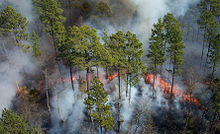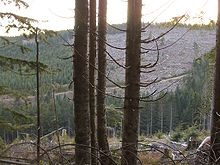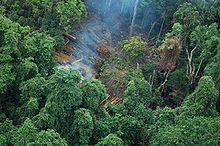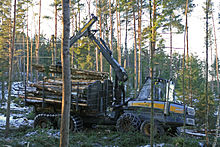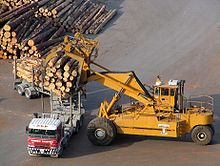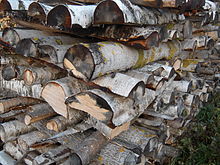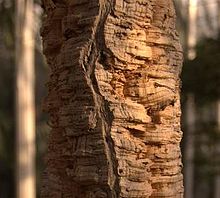- Outline of forestry
-
See also: Index of forestry articles
The following outline is provided as an overview of and guide to forestry:
Forestry – the art and science of managing forests, tree plantations, and related natural resources. Forest ecosystems have come to be seen as the most important component of the biosphere,[1] and forestry has emerged as a vital field of science, applied art, and technology. The main goal of forestry is to create and implement systems that allow forests to continue a sustainable continuation of environmental supplies and services. The challenge of forestry is to create systems that are socially accepted while sustaining the resource and any other resources that might be affected.[2]
Focus of forestry
- Tree – organism, whose species, age, vitality, growth, health, and size, are considered individually or more often, as part of a whole;
-
- Forest – defined as either a geographic area or delineated by the general composition of individuals;
-
- Biome – ecologically defined by its forest structure, leaf types, tree spacing, and climate
General Forested Biomes Boreal 
Taiga Temperate 


Coniferous Broadleaf and mixed Mediterranean Tropical/Subtropical 


Coniferous Moist broadleaf Dry broadleaf Wetlands 


Mangroves Bogs Swamps Other 

Urban Riparian Branches of forestry
- Dendrology – involves the study and identification of economically useful tree species
- Forest ecology – studies the patterns and processes of a forest ecosystem
- Silviculture – is the art and science of controlling the establishment, growth, composition, health, and quality of forests to meet specific objectives
- Forest management – comprises the overall administrative, economic, legal, and social aspects of forest regulation
- Forest mensuration – incorporates quantitative measurements of the forest stand to determine stand timber volume and productivity/health, and provides a basis off which management decisions can be made
- Forest hydrology – embodies the effects of changes in forest land use on the movement, distribution, and quality of water in the ecosystem
- Agroforestry – integration of forests into agricultural systems in order to optimize the production and positive effects within the system and minimize negative side effects of farming
- Forest pathology – research of both biotic and abiotic maladies affecting the health of the forest or tree, primarily fungal pathogens and their insect vectors
- Forest economics – studies the impact of economics on forest management decisions
- Urban forestry – entails the care and management of urban tree populations for the purpose of improving the urban environment
- Energy forestry – includes specifically managing for the production of energy from biomass or biofuel derived from a fast-growing species of tree or woody shrub
Occupations in forestry
- Forester – professional chiefly responsible for the management of forests, requires a Bachelor of Science degree in most countries
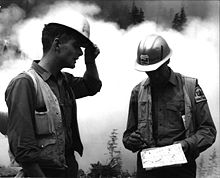 Two USFS foresters discussing firefighting tactics.
Two USFS foresters discussing firefighting tactics.
- Forest technician – individual primarily responsible for the marking of timber sales and on-ground land management, oftentimes requires a two-year Associate of Science degree
- Lumberjack – the typical feller of trees and harvester of the lumber, duties can also include:
-
- Log scaling – measurement of felled trees to determine the volume of wood going to the manufacturer
- Log bucking – delimbing and partitioning of trees into logs
- Log driving – transportation of logs on a river or lake downstream to the mill
- Arborist – professional responsible for the maintenance of individual trees in an urban forest
- Resin extractor – laborer who extracts resin from pine trees
- Rubber tapper – laborer who extracts natural rubber from tropical rubber trees
- Fire lookout – person assigned to spot for fires/smoke atop a fire lookout tower
- Hotshot crew/Handcrew – a group of wildland firefighters specialized in fire suppression tactics
- Smokejumper – firefighters who parachute into remote areas to fight wildland fires
Management focuses
- Main article: Forest management
- Analog forestry – a management focus that seeks to establish a tree-dominated ecosystem that is similar in architectural structure and ecological function to the naturally occurring climax and sub-climax vegetation community
- Community forestry – combination of forest conservation with rural development and poverty reduction objectives, accomplished through instating a legal framework that favors profitable and sustainable forest management
- Ecoforestry – emphasizes practices which strive to protect and restore ecosystems
- Hardwood timber production – process of managing stands of deciduous trees to maximize woody output
-
- Tree breeding – method of genetically modifying/selecting forest stock for improved growth or vigor characteristics
- Short rotation forestry – managing a forest that utilizes fast-growing species as a bio-based energy crop for use in power stations, alone or in combination with other fuels such as coal
-
- Short rotation coppice (SRC) – focus on species that are able to naturally regenerate through stump sprouts than maximize economic productivity
- Sustainable forest management – emphasizes practices that maintain forest biodiversity, productivity, regeneration capacity, and vitality, while continuing to fulfill relevant ecological, economic and social functions
- Tree farm – a forest or woodland owned privately where timber crop production is a major management goal
Silvicultural methods
- Main article: Silviculture
Site preparation
- Controlled burn – use of fire in order to eliminate weeds, brush, or slash, or to release on-site seeds of fire-dependent species
- Stump harvesting – removal of tree stumps either for biomass or to free up space in the soil
- Drum chopping – knocking down small trees and brush to clear the ground for planting
Planting
- Broadcast seeding – scattering of seed either by hand or mechanically over a relatively large area
- Aerial seeding – dispersing of seed from an aircraft, used especially in mountainous areas
- Treeplanting – transplanting of juvenile seedlings into the ground at a predetermined spacing
Intermediate treatments
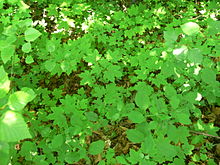 Natural regeneration of Acer platanoides in northern France, surrounded by woody and herbaceous competition.
Natural regeneration of Acer platanoides in northern France, surrounded by woody and herbaceous competition.
- Weeding – removal or reduction of herbaceous or woody species around seedlings
- Cleaning – removal of competing saplings of similar age in order to favor saplings of desirable growth characteristics
- Liberation cutting – removal of older and established overtopping trees from desirable saplings
- Thinning – removal of trees to favor the growth of select trees in order to maximize timber production
- Ecological thinning – removal of trees to favor the growth of select trees in order to favor the development of wildlife habitat
- Pruning – removal of the lateral branches on the trees in order to improve wood quality
- Pollarding – annual removal of lateral branches or main stem in order to encourage growth of branches to provide for firewood, or fruit production
Harvest rotations
- Even-aged timber management
-
- Clearcutting – harvesting of all stems in a given area regardless of species and size
- Coppicing – cutting vigorous juvenile trees near the ground, regeneration comes from new shoots coming up from the stump
- Seed-tree – cutting of all trees save widely spaced residual trees, which will provide natural seedstock for the following generation and are later cut
- Uneven-aged timber management
-
- Selection – harvesting of selected trees in a stand, removing either merchantable timber or to favor the growth of desirable individuals (a thinning)
- Shelterwood – removal of merchantable trees in succession, establishing a multiaged stand
- Variable retention – removal of trees of varying density across a landscape, in order to retain structural diversity
- Other
-
- Salvage logging – harvesting of trees killed by natural disturbances in order to maximize economic returns that would otherwise be lost
- Sanitation harvest – removal of individual trees affected by a pathogen in order to diminish the possibility the entire stand being affected
- Biomass harvest – harvesting of small wood for energy purposes, either following a commercial harvest or for its own sake, such as in energy forestry
- Underwater logging – harvesting of trees from underwater forests flooded during construction of artificial dams or reservoirs
Environmental issues pertaining to forests
- Deforestation – the removal of trees in a forested area without sufficient regeneration, resulting in desertification in arid areas and loss of habitat and biodiversity
- Afforestation – the process of establishing a forest on previously unforested land, for reasons of timber harvesting, conservation of biodiversity, or soil decontamination, among many
Illegal logging in Cambodia.

- Forest fragmentation – occurring when forests are cut down in a manner that leaves relatively small, isolated patches of forest, resulting in high amounts of edges and subsequent loss in wildlife habitat and biodiversity
- Forest dieback – where trees on the periphery of a stand are killed by acid rain or parasites
- Illegal logging – the unlawful harvest, transportation, purchase or sale of timber, contributing to deforestation, corruption, and destabilization of international markets
- High grading – type of selective logging that removes the highest timber quality trees, resulting in poor genetic stock for subsequent generations
- Forest transition – shift from a period of net forest area loss (deforestation) to a period of net forest area gain (afforestation) for a given region or country
Forest resource assessment
- Main article: Forest inventory or Timber cruise
Timber metrics
-
- Diameter at breast height (DBH) – measurement of a tree's diameter standardized at 1.3 meters (about 4.5 feet) above the ground
- Basal area – defines the area of a given section of land that is occupied by the cross-section of tree trunks and stems at their base
- Tree taper – the degree to which a tree's stem or bole decreases in diameter as a function of height above ground
- Girard form class – an expression of tree taper calculated as the ratio of diameter inside the bark at 16 feet above ground to the to that outside bark at DBH, primary expression of tree form used in the United States
- Quadratic mean diameter – diameter of the tree that coordinates to the stand's basal area
- Leaf Area Index – the ratio of total upper leaf surface of the forest canopy divided by the surface area of the land on which the vegetation grows
- Tools
-
- Biltmore stick – utilizes ocular trigonometry to quickly measure diameter and height
 Figure demonstrating the ocular trigonometric principles behind the Biltmore stick.
Figure demonstrating the ocular trigonometric principles behind the Biltmore stick.
- Diameter tape – cloth or metal tape that is wrapped around the bole, scaled to diameter
- Caliper – two prongs connected to a measuring tape are placed around the most average part of the bole to determine diameter
- Relascope – multiple-use tool that is able to find tree height, basal area, and tree diameter anywhere along the bole
- Clinometer – common tool used to measure changes in elevation and tree height
- Cruising rod – similar to a caliper, calculates the number of pieces of lumber yielded by a given piece of timber by measuring its diameter
- Hemispherical photography – estimates solar radiation and characterize plant canopy structure/density using photographs taken looking upward through an extreme wide-angle lens
- Biltmore stick – utilizes ocular trigonometry to quickly measure diameter and height
Surveying techniques
-
- Traversing – method of surveying used to establish sampling plots along a line or path of travel
 A wedge prism showing a borderline tree.
A wedge prism showing a borderline tree.
- Chain – equivalent to 66 feet, widely used distance in surveying practices in the United States and other countries influenced by imperial Great Britain
- Line plot survey – plots taken at a regular predetermined distance along the traverse path
- Tools
-
- Pacing – quick method used to survey in the field, requiring calibration of one's "paces" (pair of footsteps) to a known distance (oftentimes a chain)
- Hand compass – a compact magnetic compass with a sighting device used to determine the location of plots for a given bearing
- Wedge prism – optical instrument typically made of glass ground at slight angles to refract light passing through it from the smaller width side of the prism to the thicker width side of the prism, calibrated to a desired plot size (basal area factor)
- Angle gauge – similar in principle to a wedge prism, although it must be held a fixed distance from the eye
- GPS – global satellite navigation systems used to determine the position of oneself and plots
- GIS – an information system capable of integrating, storing, analyzing, and displaying forest geographic information collected in the field
- Traversing – method of surveying used to establish sampling plots along a line or path of travel
Timber volume determination
-
- Site index – a species specific measure of site productivity and management options, reported as the height of dominant and co-dominant trees (site trees)in a stand at a base age such as 25, 50 and 100 years
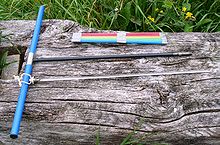 An increment borer with common drinking straws, a cost-effective manner often used to hold derived cores.
An increment borer with common drinking straws, a cost-effective manner often used to hold derived cores.
- Stocking – a quantitative measure of the area occupied by trees relative to an optimum or desired level of density
-
- Stand Density Index – a measure of the stocking of a stand of trees based on the number of trees per unit area and DBH of the tree of average basal area
- Volume table – a chart based on volume equations that uses correlations between certain aspects of a tree to estimate the standing volume
- Stand density management diagram – model that uses current stand density to project future stand composition
- Units of measurement
-
- Cord – very common measure, equivalent to 128 cubic feet (3.62 m3), corresponding to a pile of wood, bark, and air 4 feet wide by 4 feet high and 8 feet long
- Stère – invented in France, equivalent to a cubic meter of cut wood with space for air
- Board foot – specialized unit of measure for lumber in North America, equivalent to the volume of a one foot length of a board one foot wide and one inch thick
- Site index – a species specific measure of site productivity and management options, reported as the height of dominant and co-dominant trees (site trees)in a stand at a base age such as 25, 50 and 100 years
Stand growth assessment
-
- Increment borer – specialized tool used to extract a section of wood tissue from a living tree with relatively minor injury to the tree, used often for tree growth analysis
- Mean annual increment (MAI) – refers to the average growth per year a tree or stand of trees has exhibited at a specific age
- Periodic annual increment (PAI) – describes the average annual change in tree diameter between the beginning and ending of a growth period, used more often than MAI for percental growth
- Ecological yield -the amount of wood volume in any given year whose harvesting would be considered sustainable
- Growth and yield modelling – entails the creation of models of prospective tree growth and harvest yield for management purposes
- Economics
-
- Stumpage – the price charged by a land owner to loggers for the right to harvest standing timber on that land
- Optimal rotation age – the age at which the harvesting of stumpage will generate the maximum revenue or economic yield
Harvesting
- Main article: Logging
Harvesting methods
- Felling – process of cutting down a tree
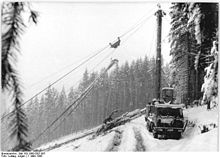 A cable logging setup in Germany (1988).
A cable logging setup in Germany (1988).
- Bucking – splitting of a felled and delimbed trees into logs
- Scaling – measurement of felled trees to determine the volume of merchantable wood
- Skidding – transportation of logs from the site of felling to the landing along the ground
- Forwarding – transportation of logs from the site of felling to the landing above the ground, usually to minimize soil disturbance but limits the size or amount of logs that can be moved at once
- Hauling – long-distance transportation of logs from the landing to their final destination, usually with a semi-truck but occasionally with a train
- Woodchipping – grinding of logs into chips for engineered wood, mulch, paper, or fuel
- Cut-to-length logging (CTL) – an expensive but efficient system where trees are felled, delimbed, and bucked to scale directly at the felling site
- Cable logging – skidding using a wire cable attached to the felled trees, most common in areas with steep topographic relief, variations include
-
- High lead logging – a cable is anchored to a tree at the top of the hill:
- Skyline logging – a carriage is used alongside the main cable to provide leverage
- Shovel logging – transport of multiple logs close to the logging road using a stationary loader, often used to minimize soil disturbance
- Heli-logging – transport of logs from the forest to the landing via helicopter, most commonly used in inaccessible areas or to minimize impact on the soil
- Log driving – transportation of individual logs on a waterway to a mill or port downstream
- Timber rafting – transportation downstream of multiple logs bundled together into a raft, considered less dangerous than log driving
Harvesting tools
- Timber felling
- Hand
-
- Axe – primitive tool used felling and splitting
- Chainsaw – portable mechanized all-purpose saw, the most common tool used in hand-felling
- Crosscut saw – saws that have teeth that are designed to cut wood at a right angle to the direction of the wood grain, used for felling and bucking
- Bucksaw – a type of crosscut saw used by one or two people to buck felled trees into sawlogs
- Mechanized
-
- Feller buncher – vehicle with an attachment that can rapidly cut and gather several smaller trees before felling them
- Harvester – first half of the CTL system, vehicle that cuts, delimbs, and bucks the logs "to length"
- Log transportation
- Ground
-
- Peavey – a traditional tool consisting of a wooden lever handle with a movable metal hook with a sharp tip, used to spear the log for handling and moving
- Cant Hook – tool with the same premise as the peavey but with blunt teeth-bearing tip
- Yarder – in cable logging, a piece of equipment utilizing a pulley system of cables to pull or fly logs from the stump to the landing
- Forwarder – second half of the CTL system, the vehicle that carries logs clear off the ground from the felling site to the roadside landing
- Skidder – vehicle that drags logs along the ground from the felling site to the roadside landing
-
- Michigan logging wheels – historical skidder, consisting of a specially designed large set of wooden wagon wheels and could be used in unfrozen soil conditions
- Skid cone – a steel or plastic cone placed on the end of a log while being skidded, in order to ease its transportation or protect residual trees
- Water
-
- Splash dam – a dam built to temporarily raise the water level of a river to float timber downstream
- Flume – chutes specifically constructed to transport lumber and logs down mountainous terrain to a sawmill by using flowing water.
-
- Timber slide – chutes constructed parallel to a river in order to avoid damage to timber rafts caused by rapids or waterfalls
- Boom – barriers placed in a river, designed to collect and or contain floating logs felled from nearby forests
Forest products
- Main article Forest product, or Wood processing
Primary forest products
Main article Wood
- Lumber – or timber, the raw material for the construction of buildings or furniture making
- Paper – made from wood pulp derived from the timber stock pulpwood
Main article Engineered wood
- Paperboard – a thick packaging material derived from paper, cardboard is the generic term
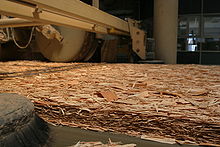 Production of oriented strand board.
Production of oriented strand board.
- Veneer – thin layers of high-quality wood, often decorative but also the primary product in plywood
- Multilaminar veneer – like veneer, but utilizes plantation wood in accordance with the principles of sustainable forest management
- Oriented strand board – mainly used in structural insulated panels, has largely replaced plywood
- Fiberboard – a cheaper and denser form of plywood, used when cost is considered most important. Oftentimes used as the underlying structure in car dashboards
- Drywall – a gypsum plaster placed inside two sheets of paper, used commonly as the finishing step in construction of interior walls and ceilings
- Wood-plastic composite – made from recycled materials, is crack- and split-resistant and used commonly outdoors
Secondary forest products
Main article: Non-timber forest products- Fuel
- Main article: Wood fuel and Biomass
- Firewood – the most unprocessed form of wood fuel, supplies the majority of the developing world's energy needs
- Pellets – a byproduct from sawmilling, is formed from compacted sawdust, easy to transport and has a high combustion efficiency
- Cellulosic ethanol and Biomethanol – second generation biofuels that are a potential replacement for gasoline
- Charcoal – derived from tar, is used extensively in cooking, industry, and water purification, among others
- Black liquor – a byproduct from pulp production, can be gasified and used as a syngas
- Byproducts
-
- Cork – used to stop wine bottles and as the core in baseball bats
- Tar – mainly used as a sealant for shingles and watercraft hulls
- Turpentine – derived from tar, historically used extensively to thin oil-based paints and a protective furniture wax
- Rubber – wide range of commercial and industrial uses, tires and tubes are the largest consumer uses
- Creosote – historically been used as a disinfectant, laxative, and to treat coughs
- Tall oil – a cheap alternative for use in soaps, lubricants, and drilling fluid
- Ecosystem services
- Main: Ecosystem services
- Carbon sequestration – a technique for long-term storage of carbon to combat global warming
- Water purification – riparian forests act as biofilters to capture and biologically degrade pollutants
- Outdoor recreation – provides the natural infrastructure needed for ecotourism
- Land rehabilitation – the restoration of degraded land to its former state, largely accomplished through phytoremediation
History of forestry
- Main article: History of forestry
- Deforestation during the Roman period – increased population growth and urbanization gave way to technological advancements that led to widespread deforestation
Notable people
- Georg Ludwig Hartig (1764–1837) – a prominent forest manager, author, and founder of many forestry universities in Germany, including one at the University of Berlin
- Franklin Hough (1822–1885) – chief of the United States Division of Forestry, the "father of American forestry"
- Bernhard Fernow (1851–1923) – laid the groundwork for the United States Forest Service, founding dean of the first professional forestry school in the United States
- Dietrich Brandis (1824–1907) – considered the "father of tropical forestry".
- Gifford Pinchot (1865–1946) – first chief of the United States Forest Service and proponent of the Wise Use Movement
- Carl A. Schenck (1868–1955) – responsible for incorporating German scientific management techniques into American forest management, and founder of Biltmore Forest School, the first forestry school in the United States
- Károly Bund (1869–1931) – an early academic and practical forester whose work in the Hungarian National Forestry Association increased treeplanting and intensified efforts to protect natural forests, indigenous tree species, and forestry workers in Austria–Hungary
- Aldo Leopold (1887–1948) – cofounder of The Wilderness Society along with Robert Marshall (below), prominent naturalist writer and environmental ethicist
- Robert Marshall (1901–1939) – cofounder of The Wilderness Society, which helped pass the Wilderness Act, which created the first legal definition of wilderness and conserved some 9,100,000 acres (37,000 km2) of national forest land in the United States
- Walter Bitterlich (1908–2008) – world-renowned Austrian scientist, best known for the invention of variable plot sampling
- Sakari Pinomäki (?) – pioneer of mechanized forest harvesting vehicles, decreasing the time required for harvesting and risk to loggers
- Stephen C. Sillett (1968- ) – revolutionized the approach and methodology of studying plant and animal life in old growth canopies of large trees
- Kenneth Dupee Swan (1887–1970) – notable photographer for the USDA Forest Service
Lists
- List of forestry universities and colleges – institutions worldwide leading to a degree in forestry
- List of woods – commonly used in the timber and lumber trade
- List of tree species by shade tolerance – tree grouped by shade tolerance, a determinant in successional status
Allied sciences
- Ecology – whose principles are the main scientific basis of forestry
- Conservation biology – conscientious management of forests can preserve or enhance biodiversity of dependent species
- Botany – study of plant life and development that explains the biological basis of trees, such as structure, growth, reproduction, metabolism, response to disease, and chemical properties
- Soil science – physical, chemical, and biological properties of soil greatly determines the success of tree species and individuals
- Ecophysiology – the study of an organism's physiology to environmental conditions that explains the success of a particular tree species' growth, reproduction, survival, and abundance
- Dendrochronology – method of scientific dating based on the analyses of tree-ring growth patterns, analysis of long-lived individual trees can provide insight into climatic conditions of the past
See also
References
- ^ http://www.tutorvista.com/content/biology/biology-iv/ecosystem/ecosystem-definition.php ecosystem part of biosphere
- ^ "Forestry." Gale Encyclopedia of Science. Thomson Gale, 2001. NA. General OneFile. Gale. 12 Oct. 2009 <http://find.galegroup.com/gps/start.do?prodId=IPS>.
External links
- State of the World's Forests (SOFO) – a report issued by the Food and Agriculture Organization of the United Nations on forest and forestry trends worldwide, last published in 2009
- Forestry Images
- International Society for Tropical Foresters
- The Forestry Commission
- The Forestry Guild
- Sylva Foundation
- International Wood Collectors Society
- Xiloteca Manuel Soler (One of the largest private collection of wood samples)
- Rainforest Alliance
- UNU Open Educational Resource on Forestry, Forest Economics and Forest Policy
Forestry by country Africa Americas Argentina · ChileAsia Europe Poland · Russia · United KingdomOceania Australia · New ZealandOutlines General reference · Culture and the arts · Geography and places · Health and fitness · History and events · Mathematics and logic · Natural and physical sciences · People and self · Philosophy and thinking · Religion and belief systems · Society and social sciences · Technology and applied sciencesCategories:- Forestry
- Outlines
Wikimedia Foundation. 2010.

